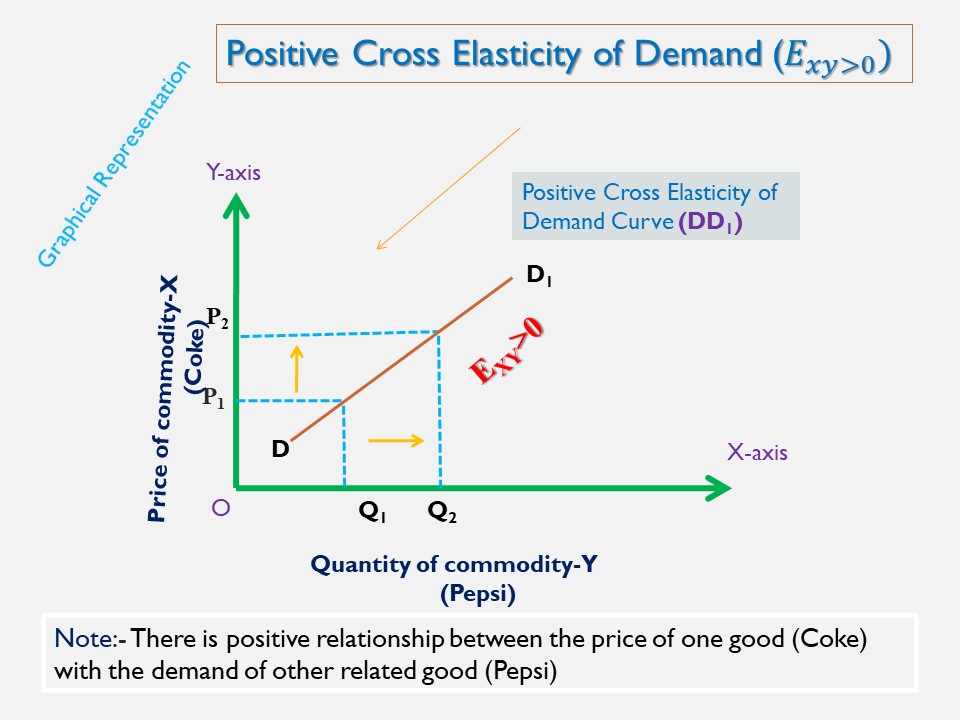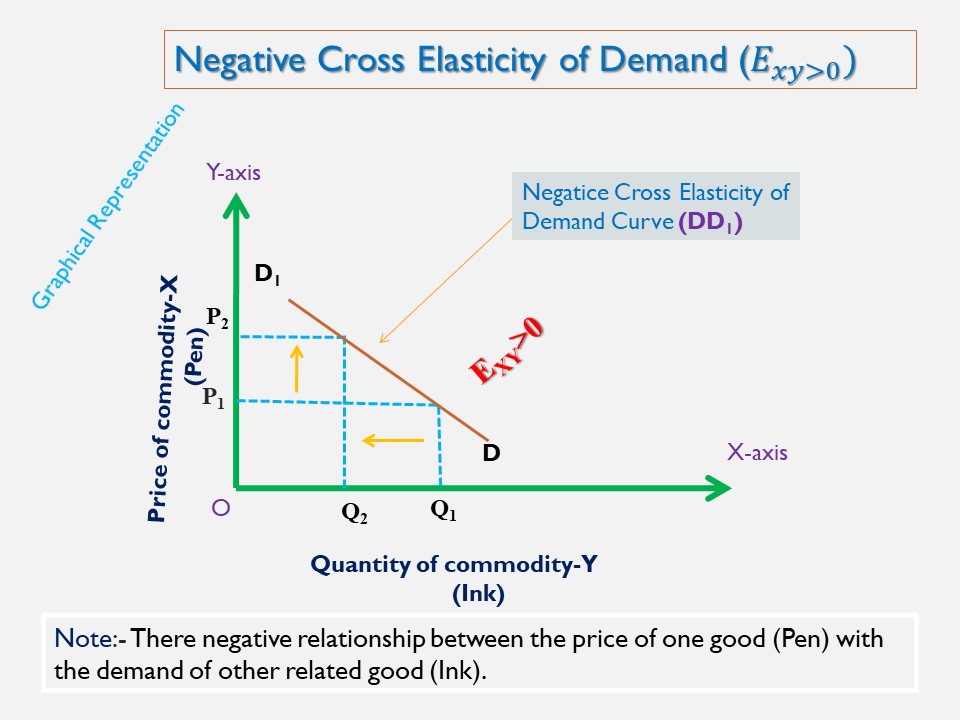What is Cross elasticity of Demand?
[su_highlight background=”#ffdb99″ color=”#0c0b0b”]Cross elasticity of demand is a measure of how much the quantity demanded of good changes, responds to a change in the price of its related goods (Substitute goods and Complementary goods)[/su_highlight]. The cross elasticity of demand for any goods measures the change in consumer behavior due to a change in the price of its related goods. Thus, the cross elasticity reflects the many economic, social, and psychological forces that shape consumer tastes. There are three types of cross elasticity of demand economists described i.e. Positive cross elasticity of demand, Negative cross elasticity of demand, and Zero Cross elasticity of demand.Let’s discuss how we can calculate cross elasticity of demand. We can calculate cross elasticity of demand by using the following equation;

Types of Cross Elasticity of Demand
There are three types of cross elasticity economists described;
- Positive cross elasticity of demand
- Negative cross elasticity of demand
- Zero cross elasticity of demand
Positive cross elasticity of demand
When demand for a commodity and the price of its related commodity change in the same direction, the cross elasticity of demand is positive. Only in the case of substitute goods, cross elasticity of demand is positive. So, positive cross elasticity of demand is known as Cross elasticity of Substitute goods. When we calculate the elasticity of two substitute goods, it’s always greater than zero or positive.

Calculate Cross elasticity of demand (Substitute goods):
Suppose when the price of coke increase from $2 to $3, then the demand of the commodity-Pepsi increased from 10 units to 15 units.
Solution:
∆QX= (15-10) units= 5 units
QX= 10 units
∆PY= $(3-2)= $1
PY=$2
Formula to calculate cross elasticity of demand;

EXY= (5/1)*(2/10) = 1 (which is Positive or greater than o)
[su_box title=”Interpretation of cross elasticity of demand” style=”bubbles” box_color=”#eef0f9″ title_color=”#3bab29″ radius=”4″ id=”Interpretation of cross elasticity of demand”]When the cross elasticity of demand is positive (greater than 0), it means the two good are substitute goods to each other. When price of one good increase then the demand for other good increase and vice-versa.[/su_box]
DD1 shows the positive cross elastic demand curve. From the figure, we can see that when the price of the commodity-X [su_highlight color=”#0c0b0b”](Coke)[/su_highlight] rises from OP1 to OP2). Then the demand for its related goods [su_highlight color=”#0c0b0b”](Pepsi)[/su_highlight] i.e. commodity-Y increases ( i.e. from OQ1 to OP2). It shows that there is a positive relationship between the price of one good to its other related goods.
Negative Cross Elasticity of Demand
When demand for a commodity and the price of its related commodity change in the opposite direction. It’s is known as negative cross elasticity of demand. Only in the case of complementary goods, cross elasticity of demand is negative. So, negative cross elasticity of demand is known as Cross elasticity of Complementary goods. When we calculate the elasticity of complementary goods, it always comes less than zero or negative.

Calculate Cross elasticity of demand (Complement goods):
Suppose when the price of Pen increase from $2 to $3, then the demand of the commodity-Ink Decline from 15 units to 10 units.
Solution:
∆QX= (10-15) units= (-5) units
QX= 15 units
∆PY= $(3-2)= $1
PY=$2
Formula to calculate cross elasticity of demand;

EXY= (-5/1)*(2/15) = (-0.67) (which is in negative or less than o)
[su_box title=”Interpretation of cross elasticity of demand” style=”bubbles” box_color=”#eef0f9″ title_color=”#3bab29″ radius=”4″ id=”Interpretation of cross elasticity of demand”]When the cross elasticity of demand is negative (less than 0), it means the two good are complementary goods to each other. When price of one good increase then the demand for other good decline and vice-versa.[/su_box]
DD1 curve shows negative cross elasticity of demand. From the figure, we can see that when the price of commodity-X (Pen) increases i.e. from OP1 to OP2. Then the quantity demanded of its complementary goods-Y(Ink) decreases i.e. from OQ1 to OQ2. From this, we can know that there is a negative relationship between the price of one good with the demand of other related goods in negative elasticity of demand.
Zero cross elasticity of Demand
When a change in the price of one good has no effect on the demand for other goods. This type of elasticity of demand known as zero cross elasticity of demand. When we calculate this elasticity of demand, its answer always equal to zero.

d[su_box title=”Example of Zero Cross Elasticity of Demand” style=”bubbles” box_color=”#eef0f9″ title_color=”#ab29a0″ radius=”4″ id=”Example of Zero cross elasticity of demand”]As we know that Pen and Petrol both are independent or unreleated goods. Increase in the price of pen does not have any effect on the quanitty demanded of petrol. [/su_box]

DQ1 curve shows zero cross elasticity of demand. From the figure, we can see that when the price of Pen increases i.e. from OP1 to OP2 to OP3. Then there is no change in quantity demanded for commodity-Petrol. From this, we can see that there is no any effect of price of one commodity to another one if the commodity is unreleated or independent on each other.
Some Question Answer related to Cross elasticity of Demand
What is cross elasticity of demand?
Cross elasticity of demand is a measure of how much the quantity demanded of good changes, responds to a change in the price of its related goods (Substitute goods and Complementary goods).
What are the types of cross elasticity of demand?
Positive cross elasticity of demand
Negative cross elasticity of demand
Zero cross elasticity of demand
Why is cross elasticity of demand important?
Cross elasticity of demand is a measure of how much the quantity demanded of good changes, responds to a change in the price of its related goods (Substitute goods and Complementary goods). The cross elasticity of demand for any goods measures the change in consumer behavior due to a change in the price of its related goods. Thus, the cross elasticity reflects the many economic, social, and psychological forces that shape consumer tastes.
How do you interpret cross elasticity of demand?
Substitute Goods:- When the cross elasticity of demand is positive (greater than 0), it means the two goods are substitute goods to each other. When the price of one good increases then the demand for other good increases and vice-versa.
Complementary Goods:- when the cross elasticity of demand is negative (less than 0), it means the two goods are complementary goods to each other. When the price of one good increases then the demand for other good declines and vice-versa.

